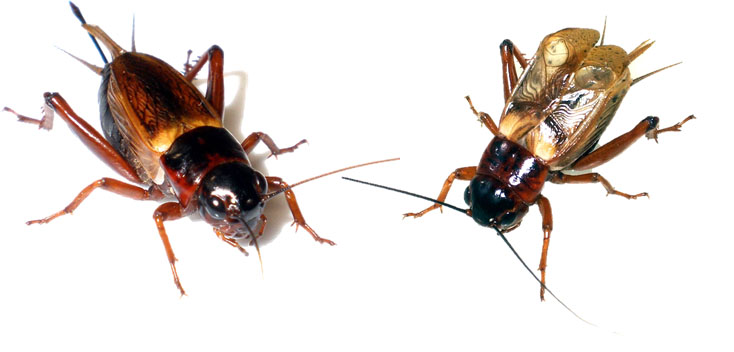Model animal and Research themes

We mainly use field cricket, Gryllus bimaculatus as material. We are studying neural system architecture for sensory information processing and motor control, by using wind-elicited escape behavior mediated by the cercal sensory system and phonotaxis behavior mediated by the tympanic organ as model systems.
Computational process of the neural network that performs cricket phonotaxis navigation

Female crickets exhibit "phonotaxis" behavior approaching to the malefs calling song. This behavior has been studied for a long time as a classical theme of neuroethology. However, it remains a mystery about how the direction of the sound source can be encoded by neural activities and how the approaching movement is controlled based on the directional information of sound source. We quantitatively analyzed the phonotaxis behavior measured on an experimental arena in the soundproof room, and clarified that the phonotaxis behavior consists of a few different phases. Now, we are trying to clarify the neural mechanism that represents the sound-source direction and implements each behavioral phase in phonotaxis by electrophysiological measurement and optical imaging of cricketfs brain activity during phonotaxis under the auditory gvirtual reality (VR)h environment that reproduces the sound environment on a treadmill.
Neural mechanism for extraction of stimulation direction in giant interneuron stsem

Crickets have a pair of mechanosensory organ called cerci, that is antenna-like appendage at the abdomen. The mechanoreceptive hairs distributed on the cercus detect the airflow dynamics surrounding animal, and inputs from the primary sensory afferents that receive are processed by local circuit in the terminal abdominal ganglion. The ascending projection neurons identified as egiant interneurons (GIs)f extract the sensory information on the direction and frequency of the airflow from the sensory afferents and convey it to higher centers such as the brain. We are trying to clarify the neural representation of the airflow direction and the information-extracting algorithm in GIs by intracellular recording and calcium imaging of GIfs dendrites.
Population coding of airflow direction by cell assemblies

Sensory information including the direction of stimulus is encoded by population activity of multiple neurons (population coding), not by a specific neuron. It is thought that the directional information of airflow is also coded by multiple ascending projection neuron groups including GIs and is read out in the cephalic and thoracic ganglia of cricket. It, however, remains unknown how many neurons contribute to the stimulus encoding and what stimulus characteristics do they encode. Now, we use Bayesian estimation to mathematically predict (decode) the stimulus direction from the neural activity recorded from a large number of neurons, and clarify the activity patterns representing the airflow dynamics and the involved neural circuit.
Cross-modal modulation of wind-elicited escape behavior by multisensory integration

The cricket's tympanal organ receives not only the conspecific song, but also the ultra sound with higher frequency. It is thought that the crickets can detect the echolocation call of bats that are predators of them. Recently, we reported that the movement direction and response threshold of wind-elicited escape walking are altered by pre-exposure of the high-frequency sound preceding the airflow stimulus (Fukutomi et al., 2015, 2017). In order to explore the neural mechanism underlying this behavioral modification by the multisensory integration, we measure the escape behavior in response to the cross-modal stimulus combined sound and airflow in various spatial-temporal patterns, and are searching for the brain neurons related to this behavioral modification.
Decision making of action selection between different escape strategies

In response to airflow stimulation, cricket shows various reactions, such as running, jumping and freezing. We examined what stimulus parameters affects the selection between gRunningh and gJumpingh, and what benefits each reaction has. Our results suggest that the escape behavior was not just a reflex but was "decided" appropriately according to the stimulus. We are currently analyzing the decision-making mechanism of escape behavior selection by recording the neural activity from freely-moving cricket.

